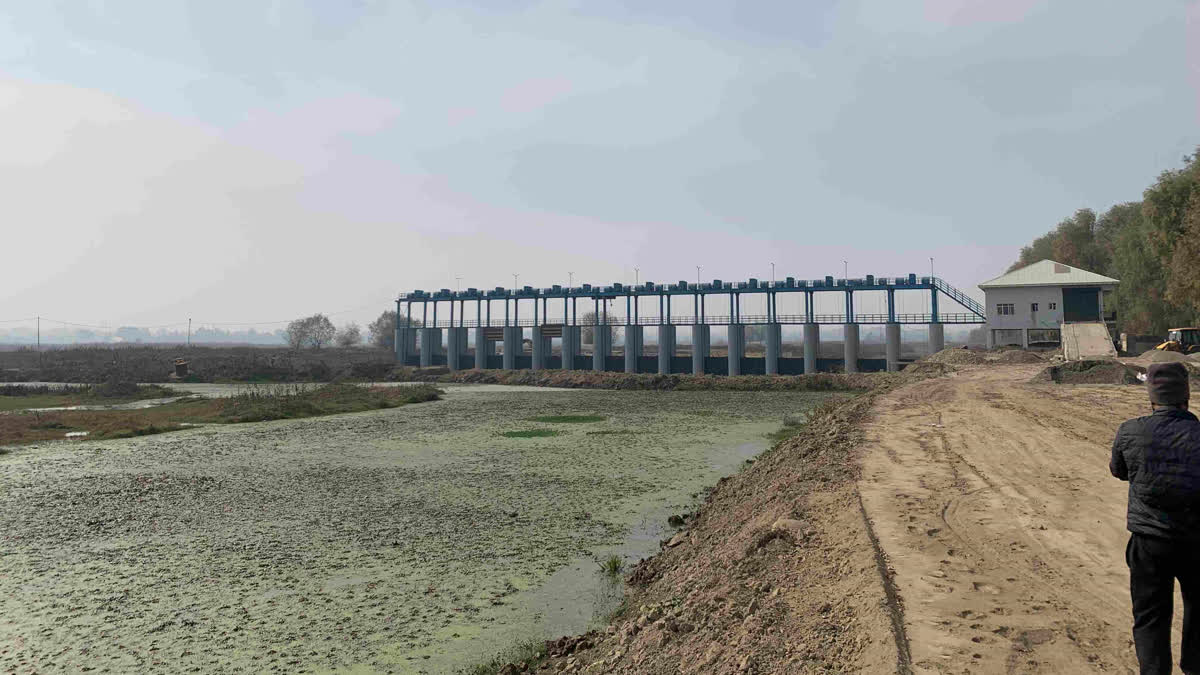Srinagar: As autumn gives way to winter, flocks of migratory birds head to Kashmir, flying thousands of miles across continents to settle in their chosen habitat, the famed wetlands of the valley.
Nearly one million such avians arrive in Kashmir for winters, far away from their summer and autumn habitats. Flying from Siberia, China, Russia and Europe, these winged guests reach the valley only to find their habitats falling prey to humans.
Over the past two decades, Hokersar, the 'queen of wetlands’ in Kashmir has faced the brunt of encroachment as soil and silt have replaced the marshy land, changing for worse the face of this prized waterbody.
About 10 kilometres away from Srinagar, Hokersar attracts over half a million birds every year due to its distinctive topography and vast expanse.
Declared a Ramsar site, an accreditation for being a wetland of international significance in 2005, Hokersar serves as 'the airport of migratory birds' to facilitate their arrival and departure. The key bird species that mark their attendance at the wetland include mallards, common shelduck, ruddy shelduck, coots, bar-headed geese, honk and waterfowls.
But for these and other species, the prospects are fast shrinking. The government, as part of its flood mitigation plan after the 2014 deluge, filled large swathes of this wetland with earth and silt. On top of that, the wetland faces widespread encroachment and pollution so much so that its size has reduced from 1875.04 hectares in 1969 to 1300 hectares now.
On November 1, this reporter walked over two kilometres of largely parched stretches in the interiors of the wetland with small batches of winged birds on the fringes of low-lying narrow pathways of muddy water.
Javeed Ganai, living in the vicinity of the wetland in Srinagar’s Zainakote for decades, says places where the wetland once thrived with several feet of water have now turned dry. On top of it, authorities have constructed a dirt track through the waterbody for moving heavy dredging machinery, literally burying all chances of its revival.
Ganai, who has done his M.Com from the University of Kashmir, says he is pained to walk over the vast dried-up stretches marked with overgrown vegetation of weeds and occasional dead carcasses of animals swarmed by flies. For the last six years, he and some other people from the neighbourhood have been working to safeguard the wetland from further deterioration.
“Hokersar was surrounded by paddy fields but now residential colonies have come up there,” he told ETV Bharat. “I see the future of this wetland as a residential colony too if the current condition continues.”
Despite this wanton degradation, the wetland continues to dish out livelihood to locals. Although sparsely, almost a dozen neighbourhoods living adjacent to Hokersar continue to collect fish, chestnuts and fodder from this dying waterbody.
“This has declined very much now, but still God is kind and gives us treasures to find at times,” says Ganai.
For the younger generation, the arrival of winged guests in the wetland has opened up new livelihood opportunities. In the last few years, youth in Kashmir have taken up birdwatching. They have documented key species and managed to publish their research in top journals, hence contributing vastly to citizen science.
“I can easily tell you the bird species by their sounds,” said Rayan Sofi, a local birdwatcher who claims to have spotted over 300 species including some rare ones.
He has acted as a guide for international and national bird watchers, allowing him to earn a decent livelihood. In August 2021, he spotted a rare bird species sharp-tailed sandpiper in the wetland, which was spotted and published in 1882 by John Biddulph in Gilgit, now located in Pakistan Occupied Kashmir (POK).
"But the condition of the wetland is disheartening," says Sofi, armed with a DSLR to spot the birds. "If this prevails, it can threaten the birds and their number will come down and affect us all."
Women too have leaped and introduced clubs and groups of birdwatchers in Kashmir. Leading among them is Mehreen Khaleel, who has a PhD in ecological sciences from the Indian Institute of Sciences, Bangalore.
Helming Kashmir-based Wildlife Research and Conservation Foundation, she organises bird-walks and conducts research around their habitat and conservation with her cohort of researchers and bird-enthusiasts.
“There’s a great upturn in birdwatching in Kashmir. We are seeing the trend and accordingly evaluating scientific aspects around birds besides also encouraging locals," says Mehreen.
She, however, remains concerned about the abysmal state of wetlands in Kashmir saying that the necessary interventions need to be made with due scientific advice and sustainability parameters in consideration to help save the tradition of migratory birds and protect the wetlands from turning into dry and polluted.
The National Institute of Disaster Management (NIDM) falling under the Ministry of Home Affairs in its report in 2023 noted that in the last four decades, Hokarsar has experienced fragmentation and changes in land use and land cover due to excessive siltation and biotic interference.
About 44.4 percent of the lakes and wetlands, according to the report, have been lost in the suburbs of Srinagar during the turn of the 21st century, affecting the microclimate of the city and exposing them to the incurrent floods. “Hokersar has receded consistently and undergone tremendous land-use change owing to siltation coupled with floods and human interference,” the report added.
In a separate study, Kashmir University’s Department of Earth Sciences corroborated the decline to “societal greed and government apathy”.
An Environmental Policy Group (EPG), comprising civil society members and experts, is alarmed over the condition of wetlands and accuses the J&K Wildlife Department of failing to protect them.
In Hokersar, the EPG claims to have found an earthwork whereby huge quantities of excavated soil were "clandestinely trucked away without any accountability".
“The total apathy by officials has reduced this waterbody into a pasture, parched land, playground and a driving learning facility,” said EPG Convenor Faiz Bakshi, while calling for a high-level inquiry into it.
The EPG has filed a Public Interest Litigation in Jammu and Kashmir and the Ladakh High Court seeking conservation, protection and management of the wetlands.
“The wildlife department has failed to manage the wetland. Hokersar is getting funds both from the Government of India and internationally for being a Ramsar site. Even water gates are not being operated. There should have been an optimal level of 3-4 feet of water but the wetland is dry and vegetation has grown here. The habitat has been disturbed and birds won’t come now.”
On the other hand, the J&K Wildlife Department’s Wildlife Warden for Wetlands Altaf Hussain said the wetland will come to life again as the pending intervention works like water management gates will be operational soon.
The two gates with sluices, part of the comprehensive flood management project, are under construction from September 2022 at an estimated cost of over Rs 28 crore. Supposed to be completed in 14 months, the project has missed multiple deadlines stretching over 25 months now.
Hussain cited a recent official correspondence to the irrigation and flood control department saying the gates would be operational "within a week".
He cited several "achievements" including 95 percent digitisation of Hokersar’s map and said they have proposed plans including digging out of silt from the wetland to increase the water holding capacity. This also includes ecotourism for sustainable livelihood to youth and bird-watching activities.
“But the intervention plan is very expensive,” Hussain added. “Now we have formed a 5-year plan and are carrying it out in a progressive manner. This will comprise dredging, removal of unwanted weeds, and navigation channels for patrolling and fencing. Development of land mass for bird resting and pool of water.”



